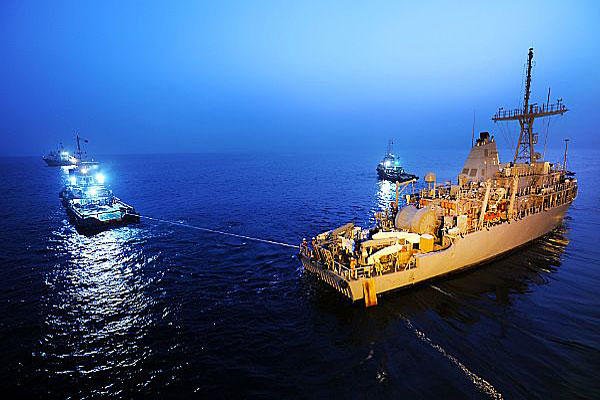Iran’s fast boats have practiced placing mines in the Caspian Sea while the U.S. Navy practices sweeping them up in the Persian Gulf in a show of brinksmanship between the two countries as tensions rise in the region over Iran’s nuclear program.
At Iran’s Caspian port of Noushahr, Supreme Leader Ayatollah Ali Khameini was on hand to observe the mine laying practice Sept. 17 by military speedboats backed up by an Iranian frigate.
Meanwhile, the U.S. Navy and about 30 other nations in the Gulf have started the International Mine Countermeasures Exercise 2012 (INCMEX).
The exercises come as Israeli leaders have reportedly discussed a possible attack to cripple Iran’s growing nuclear program. Iran has also repeatedly threatened to shut down the oil lifeline, the Strait of Hormuz, triggering a massive military buildup by the U.S. and the Gulf states over the past year.
Iran initially dismissed ongoing U.S. and allied naval maneuvers as empty posturing as Iranian leaders explained the motivation to hold a naval mining exercise.
However, a day after the start of the mining exercise, the Iranian navy launched one of Iran’s Russian-made “Kilo” class submarines and a frigate carrying anti-ship cruise missiles, the Fars news agency reported.
Iran’s actions in the Caspian and the Gulf were in response to INCMEX and the military buildup by the U.S. and Gulf allies, said Ramin Mehmanparast, an Iranian foreign ministry spokesman.
Outside forces have attempted to "trample the interests of countries of the region to secure their own interests and provoke instability and insecurity,” Mehmanparast said in a statement.
The U.S. has put two carrier battle groups in the Gulf and nearby waters indefinitely, bolstered the anti-missile defenses of the Gulf states, and deployed an F-22 Raptor squadron from the Massachusetts Air National Guard to the region.
The INCMEX exercise began Sept. 17 with meetings of senior allied leaders from participating countries at U.S. Fifth Fleet headquarters in Bahrain to “exchange ideas and view the latest mine hunting, sweeping and neutralization technologies,” according to a Fifth Fleet statement.
On Sept. 20, ships were underway to conduct “mine hunting operations; helicopter mine countermeasure operations; international explosive ordnance disposal, diving operations and small boat operations focused toward underwater improvised explosive devices.”
The sea drills were continuing through Sept. 26 in the Persian Gulf, the Gulf of Oman and the Gulf of Aden, but will steer clear of the Strait of Hormuz itself.
"We're prepared to make sure there is stability in the region. We understand that one of the threats that's possibly presented to us is a threat of mines," Vice Adm. John Miller, commander of the Fifth Fleet, told the Associated Press on Sept. 20.
"We've seen that in history so it's not unthinkable. And so it's important on an international basis that we can clear those mines from the water," Miller said.
The U.S. Navy needed the minesweeping practice, said Christopher Harmer, a retired Navy commander who served with the Fifth Fleet in Bahrain.
“Historically, the U.S. Navy just has not paid much attention to mines,” Harmer said.
The Europeans have much more experience with minesweeping from World Wars I and II than the U.S., whose home waters were never seriously threatened by mines, Harmer said.
“We do not put a lot of money into minesweeping,” said Harmer, a research analyst at the Institute for the Study of War, but the Navy’s mind-set changed earlier this year as Iran ratcheted up threats to close the Straits of Hormuz if Israel and the U.S., separately or jointly, attacked its nuclear sites.
Adm. Jonathan Greenert, the chief of Naval Operations, boosted the number of wooden-hull minesweepers in the Persian Gulf to eight and also sent eight anti-mine MH-53 helicopters to the Fifth Fleet.
Both the minesweepers and the helicopters are equipped with the Sea Fox, the German-developed underwater drone built to track mines and destroy them with an explosive warhead.
The Strait of Hormuz is about 25 miles wide. The sea lanes in either direction are only two miles wide with a two-mile buffer zone in between. Iran has warned repeatedly that it could easily shut down the passage through which about 20 percent of the world’s oil is shipped.
Greenert and Army Gen. Martin Dempsey, the chairman of the Joint Chiefs of Staff, have agreed that Iran has the capability to close the Strait, but they project the U.S. Navy could open it up again in about five days.
The Fifth Fleet billed INCMEX as “wholly defensive” and not aimed at a particular country, but defense analysts said the intent was clear.
“It’s obviously directed at Iran,” said Michael Connell, an Iran specialist at the Center for Naval Analysis. “There are no other mine threats in the area.”
The Iranians “view themselves as under siege,” Connell said, and their own mine laying exercise reflected a siege mentality. The Iranian exercise in the Caspian was small scale “but the fact that they’re doing it obviously is intended to send a message” to the U.S., Connell said.


























